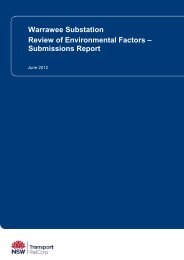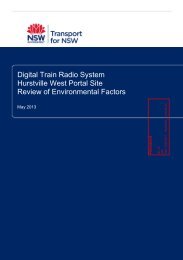Monorail Removal Project - Review of Environmental Factors (REF)
Monorail Removal Project - Review of Environmental Factors (REF)
Monorail Removal Project - Review of Environmental Factors (REF)
Create successful ePaper yourself
Turn your PDF publications into a flip-book with our unique Google optimized e-Paper software.
Map ref(figure8.1)Item name Address/location Heritage listing/s Statement <strong>of</strong> significance42 Hay StreetStormwaterChannel43 Pier St Precinct -ArchaeologicalRemains44 Water CoolingSystem - UltimoHay Street, betweenQuay and Dixonstreets, near theentertainment centreforecourtThe Pier StreetPrecinct has a listingdefined by Pier Street,Harbour Street, HayStreet and DarlingDrive (Merino Avenue)Powerhouse to MurrayStreet to waters edge,Sydney Water S170RegisterSHFA S170 RegisterSHFA S170 registercreative achievement. The surviving 19th Century interior reveals fashionable taste anddetail, especially plasterwork, stencilling and skylights. The remains <strong>of</strong> the 1830 chapelinterior give further significance to the interior, and reveal acceptance <strong>of</strong> building reuse andadaption. The School <strong>of</strong> Arts was an important educative and social centre for Sydney’sintelligensia in the 19th century and its character and spaces still demonstrate aspects <strong>of</strong> anearlier way <strong>of</strong> life. The Governor was its patron and leading citizens such as J.H. Goodlet(brick manufacturer) and Norman Selfe (engineer) served on its committee. Technicaleducation in New South Wales has its chief focus in the School <strong>of</strong> Arts prior to the transfer <strong>of</strong>the facility to the government in the later 19th century.The Hay Street Stormwater Channel system is highly significant as it was one <strong>of</strong> the first fiveoriginal combined sewers constructed in Sydney around the 1860 period. The other foursewers were; Blackwattle Bay (SHI 4570535), Woolloomooloo (SHI 4570813), Tank Stream(SHI 4573709) and Bennelong (SHI 4570854). These five sewers were responsible forgreatly improving public health by diverting stormwater and sewage <strong>of</strong>f the streets anddischarging it out into the Harbour. The five sewers are the first examples <strong>of</strong> sewerage anddrainage services to be built in Sydney, and potentially Australia. The subsequentconstruction <strong>of</strong> the BOOS (Bondi Ocean Outfall Sewer) in 1889 and the connection <strong>of</strong> theHay Street system in 1901 diverted sewer flow from the Harbour and into the ocean.Eventually the drain was used predominantly for stormwater, this further improved publichealth, hygiene and living standards for the city's residents. The channel is <strong>of</strong> technologicalsignificance as it provides an excellent example <strong>of</strong> the engineering and constructiontechniques <strong>of</strong> the late 1800s and <strong>of</strong> the city's early infrastructure. The numerous extensionsand modifications made throughout the years provide and an archaeological record <strong>of</strong> theadvancements made in drainage construction techniques. The operational curtilage for HayStreet SWC includes all original fabric and archaeological evidence including, but not limitedto the channel bed, walls and coping. There is no visual curtilage associated with thisstructure as it is located predominantly underground.Little Pier Street Precinct displays historical significance, firstly, due to being part <strong>of</strong>Dickson’s Steam Mill Complex, which included Australia’s first Steam Engine and marked thearrival <strong>of</strong> industrial technology. Little Pier Street Precinct also saw the establishment <strong>of</strong>Australia’s first salting works, which introduced innovative industrial and commercialenterprise. Aesthetically, the site contains sub surface structural features such as; walls,floors and boiler foundations. Socially, Little Pier Street Precinct has become a place <strong>of</strong> highsocial value as an archaeological site, which contains physical evidence directly related towell known events in Australia’s history. The presence <strong>of</strong> actual relics has increased theinterpretative potential <strong>of</strong> the siteThe water cooling system and manifold was an integral component <strong>of</strong> the operating system<strong>of</strong> the Power Station. The former Ultimo Power Station, (now the Powerhouse Museum)GHD | Transport for NSW - <strong>Monorail</strong> <strong>Removal</strong> <strong>Project</strong> <strong>REF</strong> | 73
















